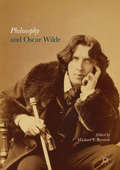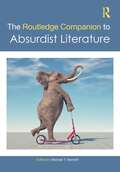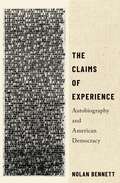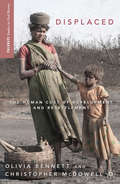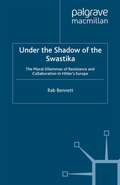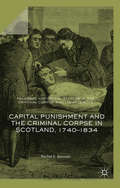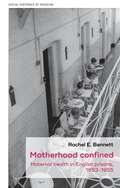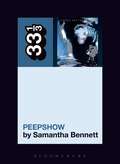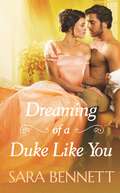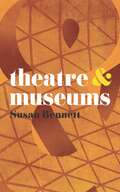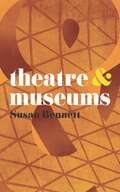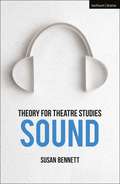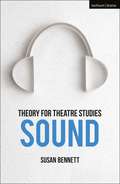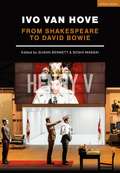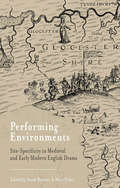- Table View
- List View
Philosophy and Oscar Wilde
by Michael Y. BennettThis book is the first collection of essays to discuss Oscar Wilde’s love and vast knowledge of philosophy. Over the past few decades, Oscar Wilde scholars have become increasingly aware of Wilde’s love and intimate knowledge of philosophy. Wilde’s “Oxford Notebooks” and his soon-to-be-published “Notebook on Philosophy” all point to Wilde not just as an aesthete, but also as a serious philosophical thinker. The aim of this collection is not to make the statement that Wilde was a philosopher, or that his works were philosophical tracts. Rather, it provides a space to explore any and all linkages between Wilde’s works and philosophical thought. Addressing a broad spectrum of philosophical matter, from classical philology to Daoism, ethics to aestheticism, this collection enriches the literature on Wilde and philosophy alike.
The Routledge Companion to Absurdist Literature (Routledge Literature Companions)
by Michael Y. BennettThe Routledge Companion to Absurdist Literature is the first authoritative and definitive edited collection on absurdist literature. As a field-defining volume, the editor and the contributors are world leaders in this ever-exciting genre that includes some of the most important and influential writers of the twentieth century, including Samuel Beckett, Harold Pinter, Edward Albee, Eugene Ionesco, Jean Genet, and Albert Camus. Ever puzzling and always refusing to be pinned down, this book does not attempt to define absurdist literature, but attempts to examine its major and minor players. As such, the field is indirectly defined by examining its constituent writers. Not only investigating the so-called “Theatre of the Absurd,” this volume wades deeply into absurdist fiction and absurdist poetry, expanding much of our previous sense of what constitutes absurdist literature. Furthermore, long overdue, approximately one-third of the book is devoted to marginalized writers: black, Latin/x, female, LGBTQ+, and non-Western voices.
The Routledge Companion to Absurdist Literature (Routledge Literature Companions)
by Michael Y. BennettThe Routledge Companion to Absurdist Literature is the first authoritative and definitive edited collection on absurdist literature. As a field-defining volume, the editor and the contributors are world leaders in this ever-exciting genre that includes some of the most important and influential writers of the twentieth century, including Samuel Beckett, Harold Pinter, Edward Albee, Eugene Ionesco, Jean Genet, and Albert Camus. Ever puzzling and always refusing to be pinned down, this book does not attempt to define absurdist literature, but attempts to examine its major and minor players. As such, the field is indirectly defined by examining its constituent writers. Not only investigating the so-called “Theatre of the Absurd,” this volume wades deeply into absurdist fiction and absurdist poetry, expanding much of our previous sense of what constitutes absurdist literature. Furthermore, long overdue, approximately one-third of the book is devoted to marginalized writers: black, Latin/x, female, LGBTQ+, and non-Western voices.
The Claims of Experience: Autobiography and American Democracy
by Nolan BennettWhy have so many figures throughout American history proclaimed their life stories when confronted by great political problems? The Claims of Experience provides a new theory for what makes autobiography political throughout the history of the United States and today. Across five chapters, Nolan Bennett examines the democratic challenges that encouraged a diverse cast of figures to bear their stories: Benjamin Franklin amid the revolutionary era, Frederick Douglass in the antebellum and abolitionist movements, Henry Adams in the Gilded Age and its anxieties of industrial change, Emma Goldman among the first Red Scare and state opposition to radical speech, and Whittaker Chambers amid the second Red Scare that initiated the anticommunist turn of modern conservatism. These historical figures made what Bennett calls a "claim of experience." By proclaiming their life stories, these authors took back authority over their experiences from prevailing political powers, and called to new community among their audiences. Their claims sought to restore to readers the power to remake and make meaning of their own lives. Whereas political theorists and activists have often seen autobiography to be too individualist or a mere documentary source of evidence, this theory reveals the democratic power that life narratives have offered those on the margins and in the mainstream. If they are successful, claims of experience summon new popular authority to surpass what their authors see as the injustices of prevailing American institutions and identity. Bennett shows through historical study and theorization how this renewed appreciation for the politics of life writing elevates these authors' distinct democratic visions while drawing common themes across them. This book offers both a method for understanding the politics of life narrative and a call to anticipate claims of experience as they appear today.
The Claims of Experience: Autobiography and American Democracy
by Nolan BennettWhy have so many figures throughout American history proclaimed their life stories when confronted by great political problems? The Claims of Experience provides a new theory for what makes autobiography political throughout the history of the United States and today. Across five chapters, Nolan Bennett examines the democratic challenges that encouraged a diverse cast of figures to bear their stories: Benjamin Franklin amid the revolutionary era, Frederick Douglass in the antebellum and abolitionist movements, Henry Adams in the Gilded Age and its anxieties of industrial change, Emma Goldman among the first Red Scare and state opposition to radical speech, and Whittaker Chambers amid the second Red Scare that initiated the anticommunist turn of modern conservatism. These historical figures made what Bennett calls a "claim of experience." By proclaiming their life stories, these authors took back authority over their experiences from prevailing political powers, and called to new community among their audiences. Their claims sought to restore to readers the power to remake and make meaning of their own lives. Whereas political theorists and activists have often seen autobiography to be too individualist or a mere documentary source of evidence, this theory reveals the democratic power that life narratives have offered those on the margins and in the mainstream. If they are successful, claims of experience summon new popular authority to surpass what their authors see as the injustices of prevailing American institutions and identity. Bennett shows through historical study and theorization how this renewed appreciation for the politics of life writing elevates these authors' distinct democratic visions while drawing common themes across them. This book offers both a method for understanding the politics of life narrative and a call to anticipate claims of experience as they appear today.
Displaced: The Human Cost of Development and Resettlement (Palgrave Studies in Oral History)
by O. Bennett C. McDowellA collection of oral histories that reveal the loss of cultural continuity, identity, shifts in family responsibilities, gender roles and fractured relationships between generations that are just some of the challenges people face as they attempt to rebuild lives and communities.
Under the Shadow of the Swastika: The Moral Dilemmas of Resistance and Collaboration in Hitler’s Europe
by R. BennettThis book is a study in the ethics of war. It is the only work which focuses on the moral dilemmas of resistance and collaboration in Nazi-occupied Europe, including a detailed examination of Jewish resistance. It presents a comprehensive guide to the harrowing ethical choices that confronted people in response to the German doctrine of collective responsibility: reprisal killings and hostage-taking. Also included: discussion of violations of the Laws of War (especially torture) by the resistance.
Capital Punishment and the Criminal Corpse in Scotland, 1740–1834
by Rachel E. BennettThis book is open access under a CC BY 4.0 license.This book provides the most in-depth study of capital punishment in Scotland between the mid-eighteenth and early nineteenth century to date. Based upon an extensive gathering and analysis of previously untapped resources, it takes the reader on a journey from the courtrooms of Scotland to the theatre of the gallows. It introduces them to several of the malefactors who faced the hangman’s noose and explores the traditional hallmarks of the spectacle of the scaffold. It demonstrates that the period between 1740 and 1834 was one of discussion, debate and fundamental change in the use of the death sentence and how it was staged in practice. In addition, the study provides an innovative investigation of the post-mortem punishment of the criminal corpse. It offers the reader an insight into the scene at the foot of the gibbets from which criminal bodies were displayed and around the dissection tables of Scotland’s main universities where criminal bodies were used as cadavers for anatomical demonstration. In doing so it reveals an intermediate stage in the long-term disappearance of public bodily punishment.
Capital Punishment and the Criminal Corpse in Scotland, 1740–1834 (PDF)
by Rachel E. BennettThis book is open access under a CC BY 4.0 license.This book provides the most in-depth study of capital punishment in Scotland between the mid-eighteenth and early nineteenth century to date. Based upon an extensive gathering and analysis of previously untapped resources, it takes the reader on a journey from the courtrooms of Scotland to the theatre of the gallows. It introduces them to several of the malefactors who faced the hangman’s noose and explores the traditional hallmarks of the spectacle of the scaffold. It demonstrates that the period between 1740 and 1834 was one of discussion, debate and fundamental change in the use of the death sentence and how it was staged in practice. In addition, the study provides an innovative investigation of the post-mortem punishment of the criminal corpse. It offers the reader an insight into the scene at the foot of the gibbets from which criminal bodies were displayed and around the dissection tables of Scotland’s main universities where criminal bodies were used as cadavers for anatomical demonstration. In doing so it reveals an intermediate stage in the long-term disappearance of public bodily punishment.
Motherhood confined: Maternal health in English prisons, 1853-1955 (Social Histories of Medicine #54)
by Rachel E. BennettWhen we imagine life behind the high walls of the fortress-like prisons that were built and modified as the modern prison system was created in the mid-nineteenth century, we conjure up scenes where strict regulation prevailed to control people in body and in mind. An image that poses something of a paradox is that of mothers and their babies living in this carceral environment. This book looks behind the cell doors of these institutions to illuminate the experiences of this group of prisoners. The management of their health alongside the management of penal discipline posed complex conundrums to the prison system. Although rarely fully considered at policy level, this balancing act was negotiated by those who lived and worked in prisons on a daily basis.
Motherhood confined: Maternal health in English prisons, 1853-1955 (Social Histories of Medicine #54)
by Rachel E. BennettWhen we imagine life behind the high walls of the fortress-like prisons that were built and modified as the modern prison system was created in the mid-nineteenth century, we conjure up scenes where strict regulation prevailed to control people in body and in mind. An image that poses something of a paradox is that of mothers and their babies living in this carceral environment. This book looks behind the cell doors of these institutions to illuminate the experiences of this group of prisoners. The management of their health alongside the management of penal discipline posed complex conundrums to the prison system. Although rarely fully considered at policy level, this balancing act was negotiated by those who lived and worked in prisons on a daily basis.
Intelligence Investigations: How Ultra Changed History (Studies in Intelligence)
by Ralph BennettMilitary intelligence, grossly neglected during the interwar period, had by mid-1942 proved itself indispensable through information gathered from intercepted radio messages in the supposedly unbreakable German Enigma cipher. Ralph Bennett, who worked for four years at Bletchley Park as a senior producer of the intelligence (Ultra') derived from the Enigma decrypts, illustrates in this collection of reprinted essays some of the steps by which he and others developed the new type of information and in the process a candid glimpse of the workings of British intelligence both past and present.
Intelligence Investigations: How Ultra Changed History (Studies in Intelligence)
by Ralph BennettMilitary intelligence, grossly neglected during the interwar period, had by mid-1942 proved itself indispensable through information gathered from intercepted radio messages in the supposedly unbreakable German Enigma cipher. Ralph Bennett, who worked for four years at Bletchley Park as a senior producer of the intelligence (Ultra') derived from the Enigma decrypts, illustrates in this collection of reprinted essays some of the steps by which he and others developed the new type of information and in the process a candid glimpse of the workings of British intelligence both past and present.
The Age of Entrepreneurship: Business Proprietors, Self-employment and Corporations Since 1851 (Routledge International Studies in Business History)
by Robert J. Bennett Harry Smith Carry van Lieshout Piero Montebruno Gill NewtonThis landmark research volume provides the first detailed history of entrepreneurship in Britain from the nineteenth century to the present. Using a remarkable new database of more than nine million entrepreneurs, it gives new understanding to the development of Britain as the world’s ‘first industrial nation’. Based on the first long-term whole-population analysis of British small business, it uses novel methods to identify from the 10-yearly population census the two to four million people per year who operated businesses in the period 1851–1911. Using big data analytics, it reveals how British businesses evolved over time, supplementing the census-derived data on individuals with other sources on companies and business histories. By comparing to modern data, it reveals how the late-Victorian period was a ‘golden age’ for smaller and medium-sized business, driven by family firms, the accelerating participation of women and the increasing use of incorporation as significant vehicles for development. A unique resource and citation for future research on entrepreneurship, of crucial significance to economic development policies for small business around the world, and above all the key entry point for researchers to the database which is deposited at the UK Data Archive, this major publication will change our understanding of the scale and economic significance of small businesses in the nineteenth century.
Constitutional Originalism: A Debate
by Robert W. Bennett Lawrence B. SolumProblems of constitutional interpretation have many faces, but much of the contemporary discussion has focused on what has come to be called "originalism." The core of originalism is the belief that fidelity to the original understanding of the Constitution should constrain contemporary judges. As originalist thinking has evolved, it has become clear that there is a family of originalist theories, some emphasizing the intent of the framers, while others focus on the original public meaning of the constitutional text. This idea has enjoyed a modern resurgence, in good part in reaction to the assumption of more sweeping power by the judiciary, operating in the name of constitutional interpretation. Those arguing for a "living Constitution" that keeps up with a changing world and changing values have resisted originalism. This difference in legal philosophy and jurisprudence has, since the 1970s, spilled over into party politics and the partisan wrangling over court appointments from appellate courts to the Supreme Court.In Constitutional Originalism, Robert W. Bennett and Lawrence B. Solum elucidate the two sides of this debate and mediate between them in order to separate differences that are real from those that are only apparent. In a thorough exploration of the range of contemporary views on originalism, the authors articulate and defend sharply contrasting positions. Solum brings learning from the philosophy of language to his argument in favor of originalism, and Bennett highlights interpretational problems in the dispute-resolution context, describing instances in which a living Constitution is a more feasible and productive position. The book explores those contrasting positions, to be sure, but also uncovers important points of agreement for the interpretational enterprise. This provocative and absorbing book ends with a bibliographic essay that points to landmark works in the field and helps lay readers and students orient themselves within the literature of the debate.
Siouxsie and the Banshees' Peepshow (33 1/3)
by Samantha BennettIn 1978, Siouxsie and the Banshees declared 'We don't see ourselves in the same context as other rock'n'roll bands.' A decade later, and in the stark aftermath of a devastating storm, the band retreated to a 17th-century mansion house in the deracinated Sussex countryside to write their ninth studio album, Peepshow. Here, the band absorbed the bygone, rural atmosphere and its inspirational mise en scène, thus framing the record cinematically, as Siouxsie Sioux recalled, 'It was as if we were doing the whole thing on the set of The Wicker Man'.Samantha Bennett looks at how Siouxsie and the Banshees' Peepshow is better understood in the context of film and film music (as opposed to popular music studies or, indeed, the works of other rock'n'roll bands). Drawing upon more than one hundred films and film scores, this book focuses on Peepshow's deeply embedded historical and aesthetic (para)cinematic influences: How is each track a reflection of genre film? Who are the various featured protagonists? And how does Peepshow's diverse orchestration, complex musical forms, atypical narratives and evocative soundscapes reveal an inherently cinematic record? Ultimately, Peepshow can be read as a soundtrack to all the films Siouxsie and the Banshees ever saw. Or perhaps it was the soundtrack to the greatest film they never made.
Siouxsie and the Banshees' Peepshow (33 1/3 #132)
by Samantha BennettIn 1978, Siouxsie and the Banshees declared 'We don't see ourselves in the same context as other rock'n'roll bands.' A decade later, and in the stark aftermath of a devastating storm, the band retreated to a 17th-century mansion house in the deracinated Sussex countryside to write their ninth studio album, Peepshow. Here, the band absorbed the bygone, rural atmosphere and its inspirational mise en scène, thus framing the record cinematically, as Siouxsie Sioux recalled, 'It was as if we were doing the whole thing on the set of The Wicker Man'.Samantha Bennett looks at how Siouxsie and the Banshees' Peepshow is better understood in the context of film and film music (as opposed to popular music studies or, indeed, the works of other rock'n'roll bands). Drawing upon more than one hundred films and film scores, this book focuses on Peepshow's deeply embedded historical and aesthetic (para)cinematic influences: How is each track a reflection of genre film? Who are the various featured protagonists? And how does Peepshow's diverse orchestration, complex musical forms, atypical narratives and evocative soundscapes reveal an inherently cinematic record? Ultimately, Peepshow can be read as a soundtrack to all the films Siouxsie and the Banshees ever saw. Or perhaps it was the soundtrack to the greatest film they never made.
Dreaming of a Duke Like You
by Sara BennettA duke with a reputation to uphold and a woman with a scandalous past take a gamble on their forbidden love in this Regency romance—perfect for fans of USA Today bestsellers Sophie Jordan and Kerrigan Byrne! Raised in a foundling home and now proprietor of a successful club, Gabriel Cadieux hasn&’t ever been welcomed by polite society. But when he discovers he&’s the legitimate heir to a dukedom, he must make a choice: accept the debt-ridden title and the trappings of the peerage who shunned him or decline and leave his six rebellious half sisters to fend for themselves. As much as he hates the idea, Gabriel can&’t abandon his siblings, even if it means making a deal with the most frustrating—and aggravatingly beautiful—woman he&’s ever met. Vivienne Tremeer storms into Cadieux&’s club with one thing on her mind: get the loathsome owner to discharge her brother&’s gambling debts. So when Gabriel offers her a trade—if she&’ll teach his wild sisters the ways of the ton, he&’ll clear the notes—she has no choice but to accept. But with her reputation already on a knife&’s edge, falling for the duke could cause the scandal of the season.
Theatre and Museums (Theatre And)
by Susan BennettBennett explores the relationship between theatre and museums, looking particularly at the collaborative processes that intertwine these two cultural practices. She argues that discourses of performance studies can open up new avenues of inquiry about the production and reception of the museum experience and its place in contemporary culture.
Theatre and Museums (Theatre And)
by Susan BennettBennett explores the relationship between theatre and museums, looking particularly at the collaborative processes that intertwine these two cultural practices. She argues that discourses of performance studies can open up new avenues of inquiry about the production and reception of the museum experience and its place in contemporary culture.
Theory for Theatre Studies: Sound (Theory for Theatre Studies)
by Susan BennettSound provides a lively and engaging overview of relevant critical theory for students and researchers in theatre and performance studies. Addressing sound across history and through progressive developments in relevant technologies, the volume opens up the study of theatrical production and live performance to understand conceptual and pragmatic concerns about the sonic. By way of developed case studies (including Aristophanes's The Frogs, Shakespeare's The Tempest, Cocteau's The Human Voice, and Rimini Protokoll's Situation Rooms), readers can explore new methodologies and approaches for their own work on sound as a performance component. In an engagement with the burgeoning interdisciplinary field of sound studies, this book samples exciting new thinking relevant to theatre and performance studies.Part of the Theory for Theatre Studies series which introduces core theoretical concepts that underpin the discipline, Sound provides a balance of essential background information and new scholarship, and is grounded in detailed examples that illuminate and equip readers for their own sonic explorations. Volumes follow a consistent three-part structure: a historical overview of how the term has been understood within the discipline; more recent developments illustrated by substantive case studies; and emergent trends and interdisciplinary connections. Volumes are supported by further online resources including chapter overviews, illustrative material and guiding questions. Online resources to accompany this book are available at:https://bloomsbury.com/uk/theory-for-theatre-studies-sound-9781474246460/
Theory for Theatre Studies: Sound (Theory for Theatre Studies)
by Susan BennettSound provides a lively and engaging overview of relevant critical theory for students and researchers in theatre and performance studies. Addressing sound across history and through progressive developments in relevant technologies, the volume opens up the study of theatrical production and live performance to understand conceptual and pragmatic concerns about the sonic. By way of developed case studies (including Aristophanes's The Frogs, Shakespeare's The Tempest, Cocteau's The Human Voice, and Rimini Protokoll's Situation Rooms), readers can explore new methodologies and approaches for their own work on sound as a performance component. In an engagement with the burgeoning interdisciplinary field of sound studies, this book samples exciting new thinking relevant to theatre and performance studies.Part of the Theory for Theatre Studies series which introduces core theoretical concepts that underpin the discipline, Sound provides a balance of essential background information and new scholarship, and is grounded in detailed examples that illuminate and equip readers for their own sonic explorations. Volumes follow a consistent three-part structure: a historical overview of how the term has been understood within the discipline; more recent developments illustrated by substantive case studies; and emergent trends and interdisciplinary connections. Volumes are supported by further online resources including chapter overviews, illustrative material and guiding questions. Online resources to accompany this book are available at:https://bloomsbury.com/uk/theory-for-theatre-studies-sound-9781474246460/
Ivo van Hove: From Shakespeare to David Bowie (Performance Books)
by Susan Bennett Sonia MassaiThis book offers a wealth of resources, critical overviews and detailed analysis of Ivo van Hove's internationally acclaimed work as the foremost director of theatre, opera and musicals in our time. Stunning production photos capture the power of van Hove's directorial vision, his innovative use of theatrical spaces, and the arresting stage images that have made his productions so popular among audiences worldwide over the last 30 years. Van Hove's own contribution to the book, which includes a foreword, interview and his director's notes for some of his most popular shows, makes this book a unique resource for students, scholars and for his fans across the different art forms in which he works. An informative introduction provides an overview of van Hove's unique approach to directing, while five sections, individually curated by experts in the respective fields of Shakespeare, classical theatre, modern theatre, opera, musicals, film, and international festival curatorship, offer readers a combination of critical insight and short excerpts by van Hove's collaborators, the actors in the ensemble companies van Hove works with in Amsterdam and New York, and by arts critics and reviewers.
Ivo van Hove: From Shakespeare to David Bowie (Performance Books)
by Susan Bennett Sonia MassaiThis book offers a wealth of resources, critical overviews and detailed analysis of Ivo van Hove's internationally acclaimed work as the foremost director of theatre, opera and musicals in our time. Stunning production photos capture the power of van Hove's directorial vision, his innovative use of theatrical spaces, and the arresting stage images that have made his productions so popular among audiences worldwide over the last 30 years. Van Hove's own contribution to the book, which includes a foreword, interview and his director's notes for some of his most popular shows, makes this book a unique resource for students, scholars and for his fans across the different art forms in which he works. An informative introduction provides an overview of van Hove's unique approach to directing, while five sections, individually curated by experts in the respective fields of Shakespeare, classical theatre, modern theatre, opera, musicals, film, and international festival curatorship, offer readers a combination of critical insight and short excerpts by van Hove's collaborators, the actors in the ensemble companies van Hove works with in Amsterdam and New York, and by arts critics and reviewers.
Performing Environments: Site-Specificity in Medieval and Early Modern English Drama
by Susan Bennett Mary PolitoThis ground-breaking collection explores the assumptions behind and practices for performance implicit in the manuscripts and playtexts of the medieval and early modern eras, focusing on work which engages with performance-oriented research.
